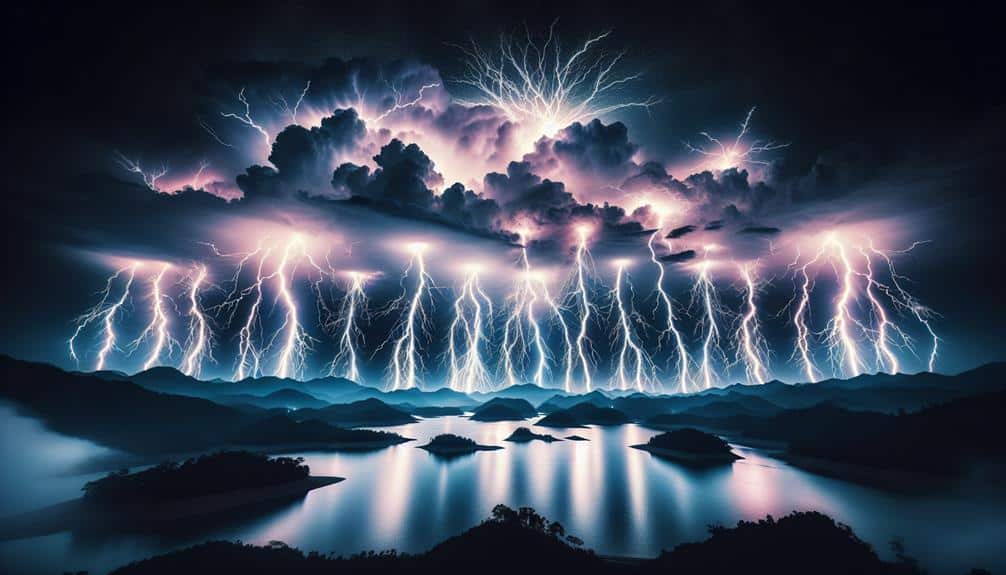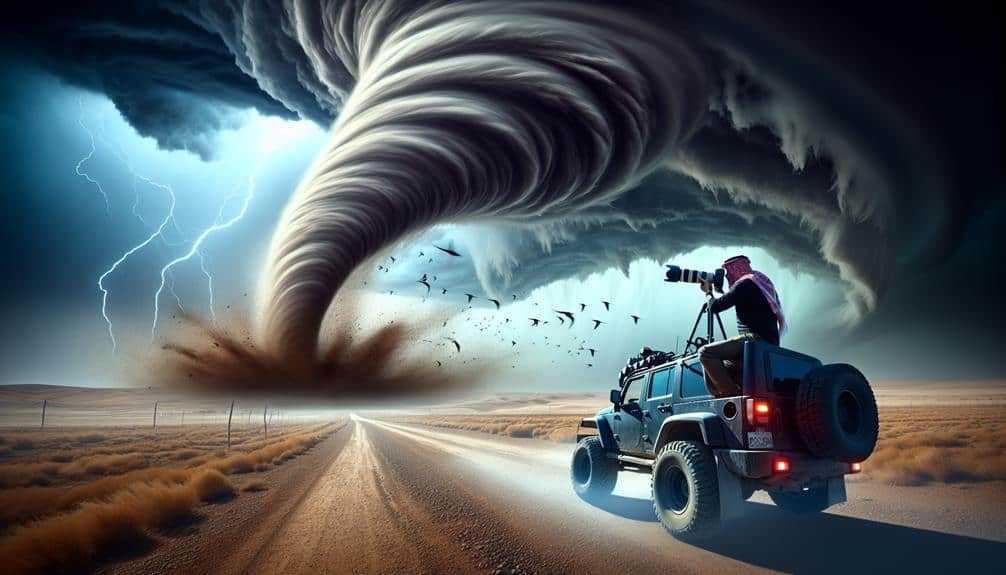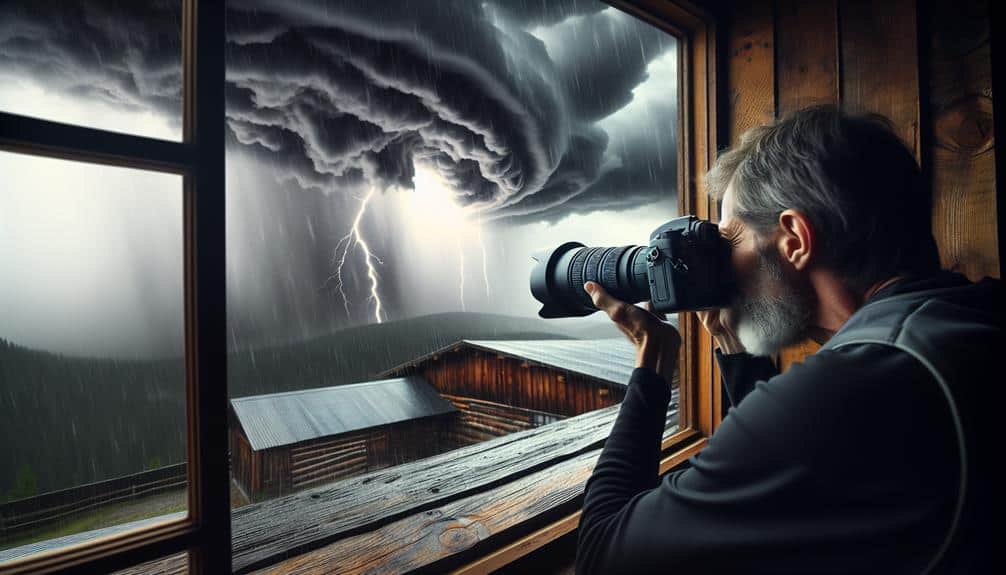Photographing thunderstorms pushes us to our limits, blending technical expertise and artistic vision. We must master storm tracking, equip ourselves with weatherproof gear, and understand intricate weather patterns. Capturing lightning requires precise timing and the right settings to harness nature's fleeting brilliance. Composing dramatic shots with balanced elements and natural light sources demands creativity and meticulous planning. Finally, our post-processing enhances the raw power of the storm, bringing out intensity and depth. Each shot is a perfect storm of skill, patience, and instinct. Stick around to discover how we tackle these electrifying challenges.
Key Points
- Capturing dynamic lightning strikes requires precise timing and technical skill to predict and photograph.
- Rapidly changing weather conditions demand constant adjustments in settings and positioning.
- Ensuring equipment safety in adverse weather while maintaining shot integrity is challenging.
- Balancing dramatic compositions with unpredictable natural elements tests a photographer's creativity.
Planning Your Storm Chase
Careful planning is necessary for a successful storm chase, requiring a blend of meteorological knowledge, logistical preparation, and artistic vision.
We start by mastering storm tracking, which enables us to pinpoint where thunderstorms are likely to develop. Accessing reliable weather models and radar data is vital, and staying updated with real-time information ensures we're chasing the most active cells.
Next, we must identify ideal locations. Flat terrains with unobstructed views, such as the Great Plains, offer perfect vantage points for capturing the grandeur of a storm. These areas not only provide clear sightlines but also allow for safe maneuvering to avoid getting caught in dangerous weather conditions.
We can't overlook safety precautions. Our safety depends on understanding storm dynamics and knowing when to retreat.
This knowledge, combined with a pre-planned escape route, keeps us out of harm's way while allowing us to focus on the chase.
Essential Gear and Safety
When we venture into storm photography, our gear and safety protocols must be meticulously planned. We need weatherproof camera equipment to withstand harsh conditions and personal safety measures to protect ourselves.
Let's explore the essentials that guarantee our safety while capturing nature's most dramatic displays.
Weatherproof Camera Equipment
As storm chasers and photographers, we must equip ourselves with weatherproof camera gear to secure both our safety and the integrity of our shots amidst the chaos of thunderstorms. Our gear needs to withstand the harshest conditions, from torrential rains to gusty winds.
First, investing in waterproof accessories is non-negotiable. A high-quality rain cover for our camera and lens guarantees that water doesn't seep into sensitive electronics.
Camera protection extends beyond just a rain cover. We should consider using weather-sealed camera bodies and lenses, designed to resist moisture and dust. These robust models provide that extra layer of security, allowing us to focus on capturing the perfect shot rather than worrying about potential damage.
Additionally, carrying a stash of silica gel packets inside our camera bags helps absorb any residual moisture that might sneak in.
Let's not forget about the tripod, an essential yet often overlooked piece of equipment. A sturdy, weather-resistant tripod ensures stability during long exposure shots, even in high winds.
Personal Safety Measures
Equipping ourselves with essential safety gear is vital to maneuvering the unpredictable dangers of a thunderstorm while capturing its raw beauty. As photographers, our quest for the perfect shot shouldn't compromise our safety.
First, let's make sure we've reliable weather apps. These apps keep us updated with real-time storm progress, giving us the crucial edge to anticipate sudden changes.
When we head out, wearing proper lightning protection gear is non-negotiable. Insulated boots and rubber gloves can be lifesavers. Additionally, identifying and having access to emergency shelters or storm shelters is key. These shelters provide a haven when the storm's fury becomes overwhelming, allowing us to regroup and stay safe.
Furthermore, carrying a portable weather radio helps us stay informed when mobile signals fail. A sturdy tripod with ground spikes ensures our equipment remains steady, even in strong winds, while we seek cover.
Understanding Weather Patterns
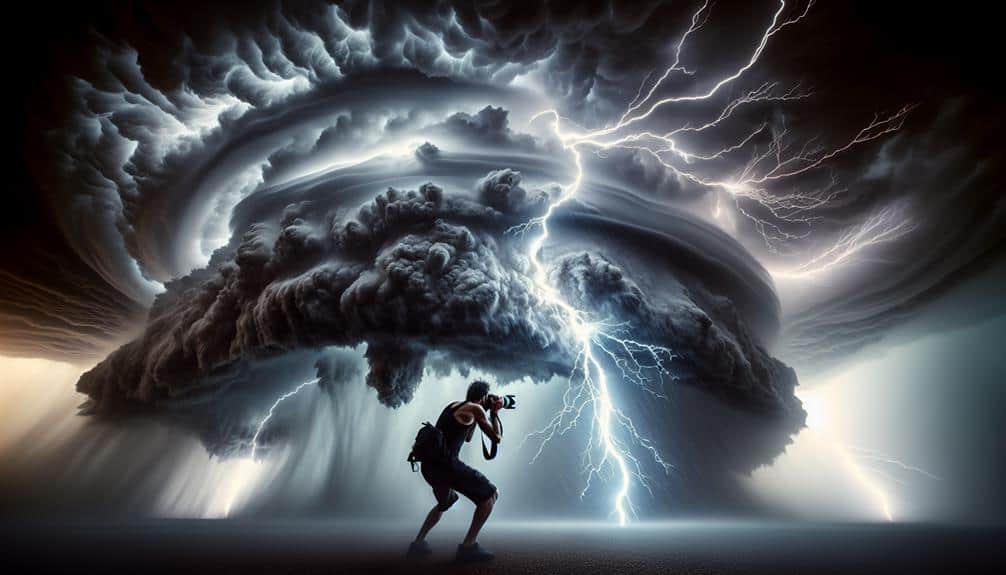
To capture the perfect thunderstorm photograph, we must first grasp the intricacies of weather patterns that precede these electrifying events. Understanding cloud formations and storm tracking is paramount. Cumulonimbus clouds, towering and formidable, are the harbingers of thunderstorms. As they develop, they signal the onset of atmospheric turbulence. By closely monitoring these cloud formations, we can anticipate the storm's progression and position ourselves for ideal shots.
Tracking storms involves using radar and satellite data to understand their trajectory and intensity. This technical expertise allows us to predict where and when the storm will peak. Observing atmospheric conditions, such as humidity, temperature, and wind patterns, further refines our predictions. High humidity and rising warm air often indicate a brewing thunderstorm, setting the stage for dramatic photography opportunities.
Let's not forget essential photography tips. Always have your gear ready and settings pre-adjusted for changing light conditions. A sturdy tripod and a weather-sealed camera are indispensable.
We embrace the challenge of capturing the raw power of nature, translating it into compelling visual art. By mastering these elements, we enhance our creative freedom, turning unpredictable weather into our most thrilling canvas.
Capturing Lightning Strikes
Capturing lightning strikes demands precision and intuition. We must time our shots perfectly, using intervalometers or manual triggers to catch the fleeting brilliance.
Managing exposure settings is essential; we balance ISO, aperture, and shutter speed to reveal the electric beauty without overexposing the frame.
Timing the Perfect Shot
How can we master the elusive art of timing to capture the breathtaking spectacle of a lightning strike? It's all about understanding the rhythm of nature and our camera's capabilities.
Lightning, with its fleeting brilliance, demands precise timing and anticipation. We must harness sophisticated lighting techniques to accentuate the dramatic contrast of stormy skies against a stormy landscape.
First, we need to scout our location effectively. A clear vantage point with an unobstructed view of the horizon is essential. We can't afford to miss the moment because of poor positioning.
Next, we employ intervalometers or lightning triggers. These devices sync our camera's shutter with the lightning's flash, increasing our chances of capturing that perfect shot.
Patience and observation are our allies. Studying storm patterns helps us predict the next strike. We watch for changes in cloud formations and listen to the cadence of thunder. Each flash of lightning tells a story, and we must be ready to capture it.
Managing Exposure Settings
Mastering exposure settings is crucial for photographing lightning strikes, as it guarantees we capture the electrical spectacle with both clarity and dramatic effect. When battling the raw power of a thunderstorm, our goal is to balance the unpredictability of lightning with meticulous exposure adjustment.
First, we need to set our camera to manual mode, allowing full control over shutter speed, aperture, and ISO. A longer shutter speed, typically between 10 to 30 seconds, increases our chances of capturing a strike. However, this requires a low ISO setting (around 100-200) to minimize noise and maintain crisp image quality.
Our aperture should be set between f/8 and f/11 to ensure a depth of field that keeps the lightning in sharp focus while maintaining the drama of the surrounding storm. We must also monitor weather conditions closely to adapt our settings dynamically.
Here are key factors to take into account:
- Shutter Speed: Longer speeds enhance our chances of capturing lightning.
- Aperture: A mid-range aperture guarantees sharpness and depth.
Composing Dramatic Shots
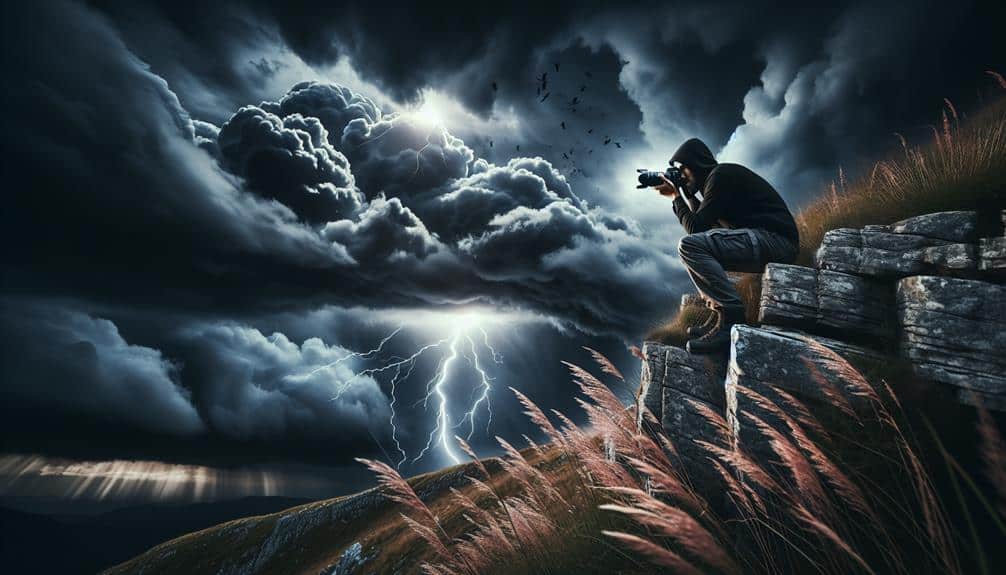
For creating truly compelling images of thunderstorms, we must meticulously balance the elements within the frame to convey both the power and beauty of the scene. Using composition techniques such as the rule of thirds, we can guide the viewer's eye to the most dramatic parts of the storm.
Placing the horizon line lower in the frame allows the towering clouds to dominate, enhancing the sense of scale and drama. Dramatic angles, like shooting upwards towards the sky, can further amplify the storm's grandeur.
Lighting effects play an essential role in capturing the essence of a thunderstorm. We should be mindful of natural light sources, such as lightning strikes, which can illuminate the clouds with a surreal glow. Timing our shots to coincide with these brief moments of brilliance can result in breathtaking images.
Additionally, color contrasts between the dark storm clouds and the comparatively lighter foreground or sky can add depth and dimension to our photos.
Post-Processing Techniques
In post-processing, we can enhance the raw intensity and beauty of our thunderstorm images by carefully adjusting exposure, contrast, and color balance. This stage is where our technical expertise and artistic vision intersect to produce stunning results.
Thunderstorm photography often requires significant color correction to accurately represent the dramatic skies. By adjusting the white balance, we can make the lightning and clouds stand out with vibrant, true-to-life colors.
Noise reduction plays a vital role in this process. High ISO settings, often necessary for capturing fast-moving storms, can introduce unwanted noise into our images. Using advanced noise reduction techniques, we can maintain image clarity and detail while eliminating graininess.
Key steps in our post-processing workflow include:
- Exposure and Contrast Adjustment: Balancing the light and dark areas to bring out the storm's full dynamic range.
- Color Correction: Fine-tuning hues and saturation to reflect the storm's intensity and mood.
Frequently Asked Questions
How Do Thunderstorms Affect Camera Sensors and Lenses?
When storms rage, our camera sensors and lenses can become vulnerable to moisture and debris. Equipment care is essential to maintain image quality. Like a delicate dance, balancing protection and creativity guarantees our shots truly capture the storm's essence.
What Legal Considerations Are There for Photographing During a Thunderstorm?
When photographing during a thunderstorm, we must respect privacy concerns, even in public spaces. For commercial use, we need to navigate copyright restrictions carefully, ensuring we have proper permissions to avoid legal issues while capturing nature's raw power.
Can Drones Be Used Safely to Capture Thunderstorms?
Can drones capture thunderstorms safely? While it's technically possible, drone regulations and unpredictable weather conditions make it risky. We need to balance our artistic vision with safety, ensuring meticulous planning and editing to achieve stunning results.
How Do I Protect My Photos From Data Corruption in Extreme Weather?
To protect our photos from data corruption in extreme weather, we use cloud storage and regular backups. We also rely on waterproof gear and cases to shield our equipment, ensuring our creative freedom remains uncompromised.
Are There Specific Insurance Policies for Storm-Chasing Photographers?
When we think about storm photography risks, consider Sarah, a storm-chasing photographer. Specific insurance policies exist, offering equipment protection coverage tailored to our unique needs. These policies safeguard us, ensuring our artistic vision thrives despite the storm's fury.
